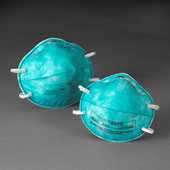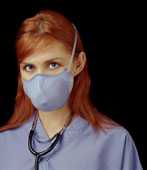NIOSH Research Rounds
NIOSH Research Rounds is a monthly bulletin of selected research at the National Institute for Occupational Safety and Health.
Volume 1, Number 2 (August 2015)
Long-term Care Facilities Can Find Challenges in Preventing TB
Preventing tuberculosis (TB) among workers in nursing homes and assisted-living facilities presents many challenges for workplace safety and health, according to a paper by NIOSH researchers published in the American Journal of Infection Control.
Older adults have higher TB rates than younger adults, and long-term care residents are more likely to have TB than people who live in their own homes. Early diagnosis and treatment are critical in long-term care facilities to protect residents and their friends and family who visit—as well as the 3 million-plus U.S. workers who provide care in these facilities.
For this case study, NIOSH investigators joined with the CDC’s TB elimination group, the Alaska Department of Health, and other partners. They focused on one 190-bed long-term care facility in Alaska found to have an unusually high number of positive TB tests from 2011 to 2012. These positive tests included 11 workers and 12 residents with latent TB infections. Further follow-up found one resident who had active TB lung disease. The investigation found that the resident with active TB lung disease likely infected all 11 workers and 8 of the 12 residents with latent infections. The source of infection for the remaining 4 residents, however, could not be found. These residents had not been near the infected resident, and airflow testing showed the infection likely did not travel through air vents.
Investigators found several challenges employers face in protecting workers from TB:
- Diagnostic—recognizing TB symptoms for older residents and the limits of tests for skin, blood, chest X-ray, and sputum.
- Treatment—managing complex drug regimens, drug toxicity, and other illnesses that may be present.
- Organizational—addressing adequate staffing, turnover rate, training, communication, and contact investigation of departing staff.
- Engineering—maintaining isolation rooms with proper ventilation.
- Administrative—tracking training; reporting of symptoms; record keeping; medical surveillance, screening, and follow-up of both residents and employees.
- Personal protective equipment—following a Respiratory Protection Program that complies with the Occupational Safety and Health Administration, and includes medical clearance, respirator fit-testing, and training.
- Culture of Safety—encouraging staff to participate; enforcing rules that protect staff, patients, and visitors; and regularly reviewing the TB program.
In This Issue
NIOSH Research Rounds is Brought to You By:
- John Howard, M.D., Director
- Fred Blosser, Editor in Chief
- Anne Blank, Story Editor
- Tanya Headley, Contributing Editor
- John Lechliter, Copy Editor
- Glenn Doyle, Technical Lead
- Mary Micciche, Technical Support
Get Email Updates
Subscribe to the NIOSH Research Rounds Newsletter:
To learn more about occupational risks of TB, visit NIOSH Workplace Safety & Health Topics: Tuberculosis.
To read the health hazard evaluation, go to Evaluation of Exposure to Tuberculosis Among Employees at a Long-term Care Facility.
To read the full journal article, go to Challenges in Assessing Transmission of Mycobacterium Tuberculosis in Long-Term Care Facilities.
Precautions Can Improve Cold-Room Comfort
Work in cold, damp conditions can be uncomfortable, even just for an hour or two. However, workers who prepare food for 8-hour shifts in refrigerated, 40°F food preparation and storage enclosures called cold rooms may feel extremely uncomfortable, have declining work performance, and be more likely to get hurt on the job.
Current safety guidelines in technical standards apply to below-freezing conditions or outdoor work, but not to cold rooms. For this reason, cold rooms are an overlooked area of work-related cold stress, and employers and workers are unlikely to have guidance tailored to their particular needs.
NIOSH researchers have recently published a report that includes information on how to help protect employees who work in the unique environment of a cold room. Responding to a request to evaluate work conditions in cold rooms at a food-catering company for airlines, NIOSH found several causes of employee discomfort:
- Air drafts.
- Unworn gloves because of concerns that bulky gear would hamper dexterity for tasks needing fine hand and finger movements.
- Insufficient training about how to work safely in a cold room.
To address these issues, the researchers suggested that the employer at the food-catering company take the following steps, which also might apply to other cold-room employers:
- Install equipment to reduce drafts and condensation.
- Give employees glove liners to wear under required plastic gloves.
- Encourage employees to change out of wet clothes.
- Rotate employees between warmer and colder areas.
- Install hand warmers, such as those that blow warm air, outside of cold rooms.
- Minimize work requiring manual dexterity in cold rooms.
Researchers also suggested that the food-catering company train employees how to avoid cold stress, and urge them to report and seek prompt medical attention for any symptoms they experience.
To learn more about cold stress, visit NIOSH Workplace Safety & Health Topics: Cold Stress.
To read the health hazard evaluation, go to Evaluation of Ergonomic Risk Factors, Thermal Exposures, and Job Stress at an Airline Catering Facility.
To read the full journal article, go to Recommendations to Improve Employee Thermal Comfort When Working in 40°F Refrigerated Cold Rooms.
Baby’s on the Way—What About Your Respirator?

N95 respirators use special N95 filters to block particles in the air. (Mention of a brand or product does not constitute endorsement by NIOSH.) Photo courtesy of 3M.
Pregnant women may turn to maternity clothes for comfort but may wonder whether they need a new respirator in the workplace. Will their fit-tested facemasks still provide a tight seal if they gain weight during pregnancy? Results of a new NIOSH study, accepted for publication by the Journal of Occupational and Environmental Hygiene, suggest that the fit-tested model of respirator provided before pregnancy will continue to fit a pregnant worker as long as she follows medical guidelines for healthy weight gain during pregnancy. A larger study is warranted to validate the findings, the researchers said.

Healthcare worker wearing an N95 respirator. Photo courtesy of Moldex.
In the United States, more than 3 million industrial workers and nearly 5 million nursing staff wear respirators to protect themselves from airborne toxins. As part of a workplace safety and health program, respirators can help stop airborne toxins from reaching the lungs when ventilation and cleaning measures alone cannot remove all contaminants, or if the cost of installing these measures is prohibitive. Because respirators must fit properly to function and significant changes in body weight can affect fit, the Occupational Safety and Health Administration requires annual fit testing. Whether pregnant women who wear respirators at work should undergo another fit testing was unclear prior to this study.
Researchers compared head and facial measurements and fit-test results of 15 voluntary participants in their second or third trimester of pregnancy to 15 voluntary, non-pregnant women similar in age, height, and weight. Besides measuring participants’ weight, height, and body-mass index, the researchers measured 13 head and facial dimensions that typically determine respirator fit. They then performed fit tests with N95 respirators, the most commonly used respirator in U.S. industry and healthcare. After comparing these detailed facial measurements and fit-test results between the two groups of participants, the researchers found no significant differences.
For more information, visit NIOSH Respirator Trusted-Source Information.
To read the unedited manuscript accepted for publication, go to: Effect of Pregnancy Upon Facial Anthropometrics and Respirator Fit Testing.
Better Sleep after Brain Injury May Aid Recovery
Most of us at some time in our modern, high-tech lives have had problems falling asleep or staying asleep—the classic tossing and turning of insomnia. For people who have had a traumatic brain injury like a concussion, sleep trouble related to the injury can persist for months and cause serious medical problems such as chronic headaches, difficulty concentrating, and depression.
In the United States, 7 million traumatic brain injuries occur each year, with nearly half related to motor vehicle crashes. The body needs sleep so it can repair and regulate itself. Research shows that a brain injury can prevent sleep by damaging areas that control the sleep/wake cycle, or circadian rhythm.
NIOSH researchers and their West Virginia University partners report that understanding and controlling sleep disruption after traumatic brain injury is important to help people with brain injuries resume healthy work and life routines. In a literature review in the journal Neuroscience and Biobehavioral Reviews, the researchers discuss psychiatric and pharmacologic sleep treatments that may aid recovery and decrease some medical problems that a traumatic brain injury causes.
These treatments include cognitive-behavioral therapy to improve sleep habits and synthetic versions of the naturally occurring hormone melatonin, which regulates circadian rhythm. Further research is necessary to identify other treatments and to determine whether treating sleep disruption can decrease the debilitating symptoms associated with traumatic brain injury.
To learn more about traumatic brain injury, visit NIOSH Workplace Safety & Health Topics: Traumatic Occupational Injuries.
To read the full journal review, go to Sleep Disruption and the Sequelae Associated With Traumatic Brain Injury.
Role-Play Decreases Bullying among Nurses
Role-play is an effective technique to teach ways to prevent bullying in nursing schools, according to NIOSH research published with university and other partners in the Journal of Nursing Education and Practice.
Previous studies have shown that emotional bullying by experienced nurses toward their new colleagues is a prevalent problem in undergraduate nursing schools. Like other kinds of bullying, emotional bullying in the workplace can affect employee health and safety. In one study, a sample of novice nurses said that bullying caused them to work uncomfortably fast, and it even caused them to consider leaving the program. In extreme cases, these effects could compromise patient care by impairing a nurse’s ability to practice effectively or, even, at all.
In the current study, volunteers included seven female students and one male student in their senior year of the nursing program at the same Midwestern university. After receiving written instructions explaining their role as either bully, bullied, or bystander, the volunteers did the role-play. Examples of the types of bullying behavior portrayed include using condescending words, insults, ridicule, and intimidation.
In interviews and focus groups afterwards, the participants’ responses showed that the role-play had strong effects:
- It increased awareness of bullying, several participants said. They were unaware of bullying behavior before the role-play began but, afterwards, realized that it was a big problem.
- It provided tools to stop bullying behavior, some of the participants felt. These tools include using conflict-resolution techniques to compromise and negotiate with a bullying co-worker.
- It taught the importance of bystander support in diffusing bullying, several participants said. This support could be as simple as standing next to or just behind a co-worker experiencing bullying, the researchers stated.
Further research is needed to clarify how nursing programs can use these and other techniques to prevent bullying, the researchers said.
Study limitations include the small number of participants and the disproportionate number of women, although the second limitation reflects that currently most nurses are women.
To read the full journal article, go to Qualitative Evaluation of a Role-Play Bullying Simulation.
- Page last reviewed: August 24, 2015
- Page last updated: August 24, 2015
- Content source:
- National Institute for Occupational Safety and Health (NIOSH) Office of the Director


 ShareCompartir
ShareCompartir